Best Star Tracker for Astrophotography in 2023
![]()
So, you have decided you want to take your astrophotography to the next level… maybe you want to capture more detail in the Milky Way core, or perhaps dabble with deep space objects like Andromeda or Orion or maybe you came from my all-in-one astrophotography tutorial. Whatever it is, you know you are looking at buying a star tracker.
This guide will walk you through each model on the market today so you can make an educated decision on which will suit your needs best. This is not going to walk you through how to set up and use your tracker. That information can be found in my guide here.
Note: I am not affiliated with any single brand or product on this list. The tracker I own is a result of my own research which has led me to the tracker that fits my needs.
Let’s jump right into it, there is a lot to cover.
Table of Contents
DIY Barn Door Tracker
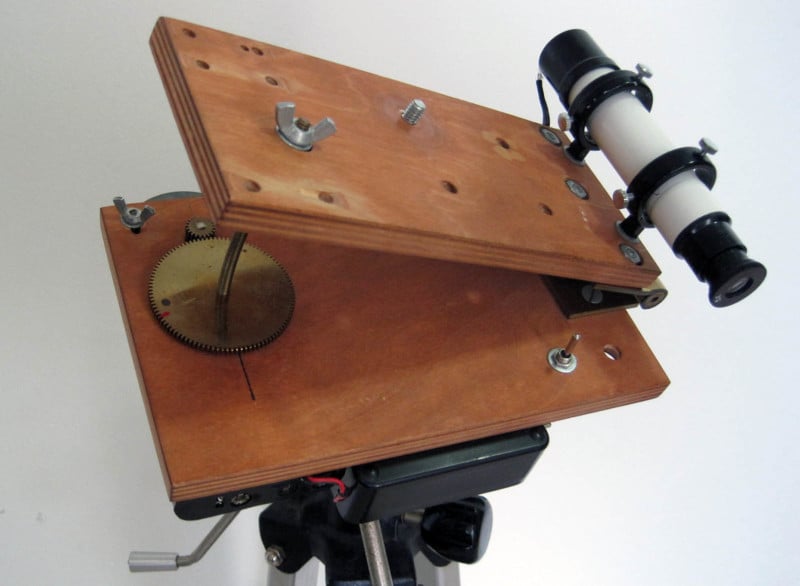
Perhaps you are handy and on a tight budget. This is a build your own tracker! These work by combining a few pieces of wood and a motor. One piece of wood has a 3/8 female thread on it to secure it to your tripod, and the other piece has a 3/8 male to mount your ball head. The two pieces of wood are held together by the motor to allow it to spin, and the motor is set to move at the Earth’s sidereal rate (23 hours and 57 minutes per day). You can buy all components for about $20, and probably assemble the entire thing in an hour. The tracker gets its name as the pieces of wood effectively look like “barn doors.”
This low-budget, hands-on approach to tracking will certainly improve your widefield shots, and for deep space it is absolutely better than nothing. It is hard to beat the capabilities for the price, so long as you are willing to make it yourself. There is certainly going to be some periodic error when using these, so it may be best to limit your exposures to less than 1 minute depending on your focal length. I also would be cautious of how much weight you would want to put on a barn door tracker, I would keep it to smaller DSLRs and mirrorless with lightweight lenses. Portability may be a slight issue here as well as these tend to be fragile. It would not be something I would want to bring on a hike.
Pros
- Very low budget.
- Relatively simple to use.
- Great way to dive into the world of tracking.
Cons
- Have to build it yourself.
- Fragile.
- A bit bulky and odd.
- Only ideal for lightweight setups.
- Not expandable. No guider or remote capabilities.
- Sidereal tracking only. No options for the Moon or the Sun.
My take: This is a great way to step into the world of tracking on a tight budget while also offering a fun side project. This is ideal if you only shoot every now and then, but those wishing to be more frequent with astrophotography may find themselves outgrowing it quickly.
Availability: Build it yourself.
NYX Tracker
![]()
The NYX Tracker is basically a barn door tracker that comes with all of the parts you need to put it together. Maybe you still want to DIY a tracker, but don’t know where to start with cutting wood and buying motors, etc. This approach is a far easier way to build one yourself, albeit at a higher cost. Still, as trackers go it is very reasonable.
Pros
- Low budget.
- Relatively simple to use.
- Great way to dive into the world of tracking.
- Easier to put together than a barn door tracker as it comes with all components pre-cut.
Cons
- Still have to build it yourself.
- Fragile.
- A bit bulky and odd.
- Only ideal for lightweight setups.
- Not expandable. No guider or remote capabilities.
- Sidereal tracking only. No options for the Moon or the Sun.
- As far as I can tell it is currently sold out online, and there is no word on when more will be made.
My take: Just like the barn door tracker, this is a fun little side project to take on and will get you much better results than standard untracked astrophotography.
Availability: $125 from the NYX Tracker website (but currently sold out)
Omegon Mount MiniTrack LX3
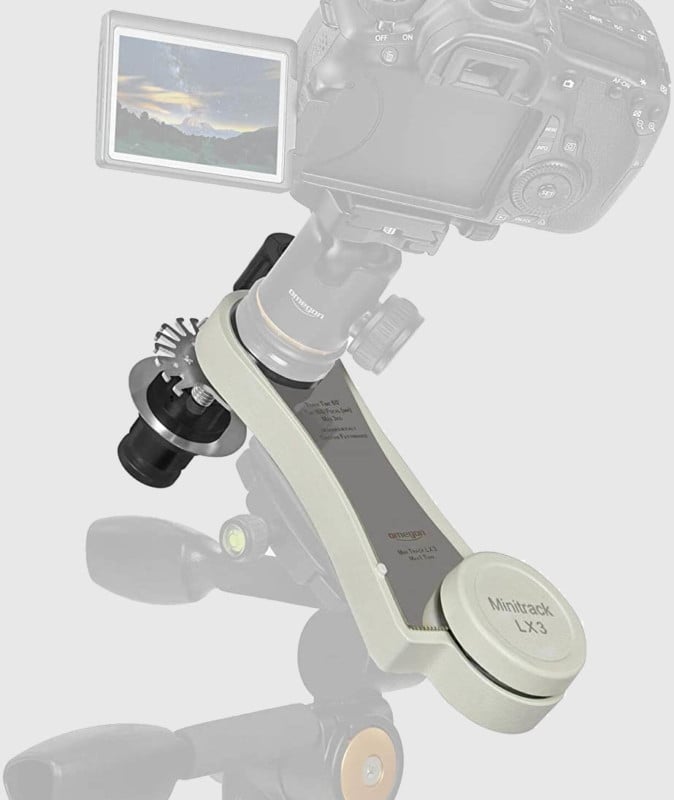
The Omegon Mount MiniTrack LX3 is awesome! It is a relatively lightweight and portable mechanical tracker which is fairly capable of even some deep space objects depending on the setup. It features a full-fledged polar scope and offers an alt-az wedge as an option to make polar aligning much easier. It is also relatively well made and is pretty well priced. The downside is that it is a mechanical tracker and will need to be reset after 60 minutes. The good thing about this though is it never requires battery power.
Pros
- No assembly is required. Works right out of the box.
- Polar scope for polar alignment.
- Relatively small and lightweight.
- Great if you don’t want to DIY but still have a tight budget.
- No battery required.
- Reasonably capable of imaging bigger deep space targets with some lightweight gear.
- Well-made.
Cons
- Only 60 minutes of tracking at a time.
- Limited load capacity. Still not capable of big zoom lenses or a mosaic setup.
- Alt-az wedge is a separate, but pricey option.
- Polar scope is detachable, can be cumbersome.
- Sidereal tracking only, no options for the Moon or the Sun.
My take: Great for anyone expanding their hobby and are looking for something that will last them quite some time. Also solid for anyone looking to travel with their gear. But, if you want to use heavier gear or shoot panoramas, you may find yourself limited with this option.
Availability: $171 from Amazon.
Move Shoot Move
![]()
The Move Shoot Move Tracker is the first tracker on the list I would recommend for hikers. It is extremely compact and lightweight at only 1.1 lbs for the device only. It really is a hiker’s dream. It has a built-in battery, but can also be powered externally for extended run times. There is no tracking limit unlike the models above, and it can be used as a makeshift timelapse rotator when mounted horizontally.
With great portability comes compromise. Like the other mounts above, this should only really be used to image widefield Milky Way and nightscapes. It is capable of some bigger deep space objects with a lightweight mirrorless setup, and you can add in tracked mosaics as well, but there is still a chance many of your exposures will have star trails if you load the mount with a heavy ball head and pano head.
The mount is typically optioned with a laser for polar alignment, but I find this a bit imprecise and some regions may even forbid this. I also feel that can be a bit distracting when using it around other people. For those reasons, I would recommend spending the extra $10 and getting the actual polar scope. This mount also does not come with an alt-az wedge which I would recommend for easy polar aligning, but that option brings its price up to the more capable iOptron Skytracker Pro which comes standard with that option. The tradeoff here is maximum portability with the MSM.
Pros
- Easily offers the most compact form factor for the price.
- Can be also used as a timelapse rotator.
- Very simple setup.
- Ideal for hiking.
- No tracking limit.
- Expandable power with USB port.
- Can be used with a lightweight panorama setup.
Cons
- Polar scope is not standard.
- Price is close to the more capable iOptron Skytracker pro when configured with alt-az wedge.
- 5 hour battery life is relatively short.
- Not the most ideal for deep space objects.
My take: This is the one to get if you plan on hiking a lot and only plan to shoot wide-mid range focal lengths. My recommendation would be to add in the alt-az wedge and polar scope to make polar alignment a breeze. While this puts it on par with the iOptron Skytracker Pro in terms of price, it still has a huge lead in portability.
Availability: $149+ from Amazon.
iOptron Skytracker Pro
![]()
Now we are stepping up in size, price, and of course capability. The first version of the iOptron Skytracker Pro tracker was the first star tracker I ever owned, and it comes from a brand that has always made a great astrophotography mount. It is compact while being lightweight and easy to transport. It is something you can for sure take on a hike, just maybe not as compact as the MSM. Additionally, it has a load capacity suitable for larger deep space objects and has an actual motor drive to allow for essentially “unlimited” tracking.
There is also a built-in battery and it offers modes to track the Moon and Sun in addition to the stars. There is also a “1/2 mode” which sets the tracker at half speed so you can shoot a single exposure instead of doing a foreground. Honestly, I would personally stay away from this feature as both your sky and foreground end up becoming blurred, so it is best to just shoot a tracked sky and then an untracked foreground and blend each layer. There is a detachable illuminated polar scope included and the alt-az base for easy polar alignment comes standard. There is an optional declination bracket with a counterweight as well for shooting deep space.
Pros
- No tracking limit.
- Illuminated polar scope and alt-az base come standard.
- Compact and light.
- Well constructed.
- Brand name with good customer support.
- Multiple tracking modes.
- Very usable for deep space objects.
- Built-in rechargeable battery.
Cons
- Counterweight with shaft and bracket is a separate option.
- Polar scope is detachable, can be cumbersome.
- The racket to attach the ball head to the tracker can be known for slipping. The knobs need to be tightened down significantly.
- No camera port for camera control, which is surprising at this price point.
- Mid-tier level pricing.
My take: This is ideal if you still want to travel and hike with your gear, but also want the added bonus of being able to shoot some more deep space objects. This is the one to get over the Move Shoot Move if you are willing to sacrifice some portability for more capability.
Availability: $329 from Adorama.
Sky Watcher Star Adventurer Mini
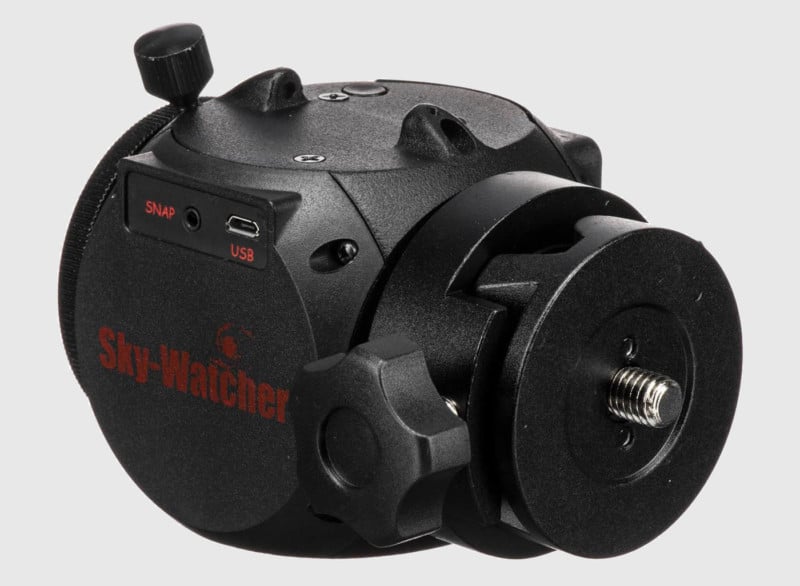
Similarly specced to the iOptron Skytracker Pro, the Sky Watcher Star Adventurer Mini is Sky Watcher’s direct competitor. Like iOptron, Sky Watcher is a very reputable brand for astrophotography equipment. The mount differs in several ways, and those differences may sway you one way or the other.
The mount is compact, and just like the iOptron its polar scope is a detachable component from the mount. There also is no built-in battery. You need to use 2 AAs. However, there is a Mini USB port that allows the mount to be powered externally. This may actually make it last longer than the iOptron. Additionally, there is also a snap port for camera shutter control, and it also has built-in Wi-Fi for control as well. Personally, I like to stay away from the complexity of adding Wi-Fi and apps to things, but I see the merit here as it is useful to change the tracking mode and control your camera remotely. Still, I would rather just have a button or switch built onto the mount though personally, but this is nifty as it potentially eliminates the need to bring along a separate remote as you can control everything through your phone. For hikers, this can be seen as a pro and con at the same time as it puts more reliance on your phone battery out in the field, but also reduces the weight and space of bringing along a remote.
The alt-az base does not come standard, which is a bit of a letdown considering the iOptron is nearly identical in price at the time of writing and it does. The assembly which holds the ball head to the mount is a lot more robust, however.
Pros
- No tracking limit.
- Very compact and light considering its capabilities.
- Well constructed and a sturdy ball head support.
- Brand name with decent customer support.
- Very usable for deep space objects.
- Expandable power with Mini USB port.
- Camera control capable with SNAP port, eliminating the need for a separate external intervalometer.
Cons
- The alt-az polar aligning bracket, counterweight assembly, and declination bracket are a separate and pricey option. When bundled, they make the price comparable to the much more capable iOptron Skyguider Pro/
- Polar scope and illuminator are both detachable, can be cumbersome/
- Multiple tracking modes only selectable via console Wi-Fi app/
- AA batteries power the mount. I recommend you purchase rechargeable AAs/
My take: This one is confusing. The benefits of purchasing this model over the iOptron Skytracker Pro I feel are made irrelevant when you factor in the additional price for the alt-az base which comes standard with the iOptron. The main selling point here is the expandable power and Wi-Fi camera control, but just remember that comes at a premium of paying extra for an alt-az base—something its competitor already comes standard with.
Availability: $335 from Adorama.
iOptron Skyguider Pro
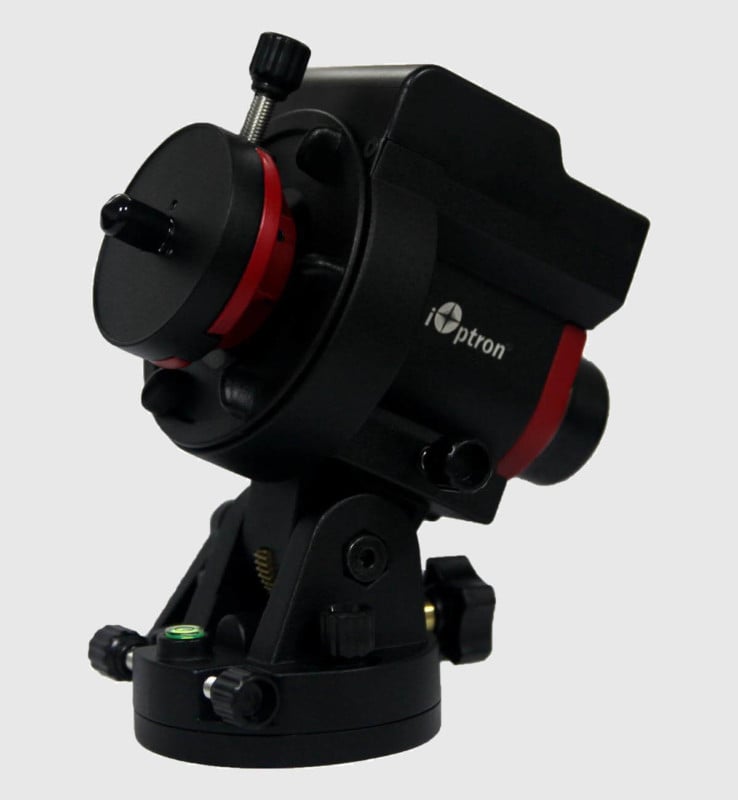
Not to be confused with the Skytracker Pro, the iOptron Skyguider Pro model is iOptron’s top-of-the-line star tracker offering. It features camera control support, guiding support via ST-4, hand controller support, a built-in rechargeable battery and it has an integrated illuminated polar scope. Additionally, the mechanism holding either a ball head or the declination bracket is beefed up for adequate grip. The standard configuration is the full package which comes with the alt-az base, declination bracket, and counterweight with shaft. There are also modes for sun, moon, 1/2 speed, and even a manual slew feature which is handy for finding deep space targets.
It has an 11 lbs load capacity which is the highest so far, and it can easily handle large-to-medium-sized deep space objects. I have used it with a heavy DSLR and 200-500mm lens setup with a guider piggybacked and it has done just fine. The mount is the heaviest of the bunch mentioned here thus far, but it still is portable enough to be taken on hiking trails which I do with mine.
Pros
- No tracking limit.
- Built-in battery.
- Built-in illuminated polar scope.
- Alt-az base, counterweight with shaft, and declination bracket come standard.
- Manual slew control.
- 11-pound load capacity making it very capable for its size and weight class.
- Guiding support and remote control support.
- Extremely well built and durable.
- Handles deep space and pano setups really well.
Cons
- Expensive, $488 before tax at the time of this writing.
- Alt-az base is flimsy and imprecise for this price point. It is acceptable on the Skytracker Pro, but this much more expensive mount deserves better.
- Declination bracket is not as smooth, making it difficult to frame up deep space objects.
- No option for timelapsing or Wi-Fi like the Star Adventurer below.
- No way to dither without using a guider.
My take: This is my personal mount of choice as it offers a few key advantages for hikers over the below-mentioned Sky Watcher Star Adventurer, but can also be used for deep space when paired with the declination bracket and counterweight. This is a mount that will last you for years to come without the need for upgrading unless you plan to get a full-sized EQ for deep space.
Availability: $488 from Adorama.
Sky Watcher Star Adventurer 2i
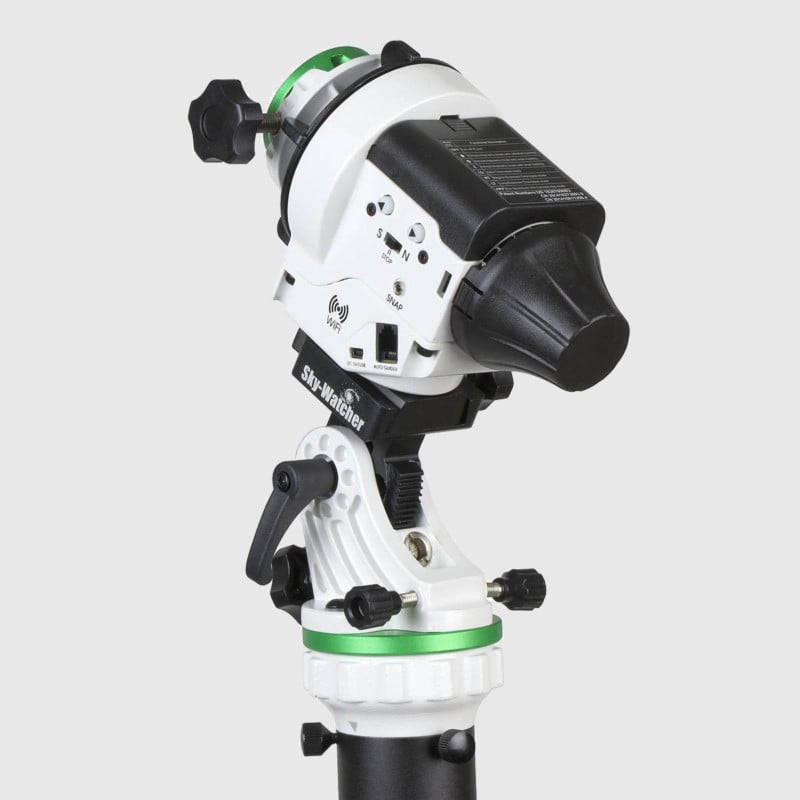
Like the iOptron Skyguider Pro, the Sky-Watcher Star Adventurer 2i is not to be confused with the smaller Sky Watcher Star Adventurer Mini. It has a much more capable 11 lbs load capacity and comes standard with an alt-az base, polar scope, and declination bracket with counterweight. It takes 4 AA batteries and can also be powered externally via mini USB.
Just like the iOptron Skyguider Pro, it has a port for an ST-4 guider, manual slew control, camera control, and multiple shooting modes selectable via a mode dial. This tracker also features a 6x or 12x function for timelapses and is also controllable via Wi-Fi. The main benefit of Wi-Fi control here though is the ability to make the mount dither in between shots and program your camera, something that is not possible on the iOptron.
There are also two more big benefits over the iOptron here. The alt-az base is way more fluid and precise, and the declination bracket offers a fine-tune adjustment. This is extremely handy for finding deep space objects. The polar scope on this mount is built-in like the iOptron, but the illuminator is a separate little part that detaches which can be frustrating. This mount is also slightly bigger and bulkier than the iOptron, and the mode dial switch can turn on easily in a backpack.
Pros
- No tracking limit.
- Alt-az base, counterweight with shaft, and declination bracket come standard.
- Manual slew control.
- 11lbs load capacity making it very capable for its size and weight class. Handles deep space and pano setups like a champ.
- Guiding support.
- Wi-Fi is great in this case for tinkering with the mount as well as the dither function.
- Declination bracket is super precise making it much easier to frame up targets at longer focal lengths.
- Alt-az base is relatively well made.
- Can also be used as a timelapse panning head.
- Expandable power via Mini USB.
Cons
- Expensive, at the time of writing $449 without taxes, with a price increase to $520 soon.
- AA batteries power the mount. I recommend you purchase rechargeable AAs.
- Polar scope illuminator is detachable, making it sometimes cumbersome.
- Mode dial selector is flimsy and easy to bump into a different mode by mistake.
- Battery cover door is also a bit flimsy and easy to knock off… I suggest gaff tape!
- Slightly bigger size making it a little less portable to travel and hike with.
My take: This is the tracker to get if you plan to prioritize deep space objects. The bigger size and slightly more cumbersome portability due to the detached polar scope illuminator and quirky mode dial make it a little less hiker friendly than the iOptron, although certainly still doable for sure. The more precise declination bracket, dithering via wifi, and better alt-az base are a huge plus when shooting at longer focal lengths which the iOptron cannot compete with.
Availability: $449 from Adorama.
Fornax LighTrack II

The Fornax LighTrack II is the last tracker on this list and also the most capable. But, it is the least portable of the bunch to the point where you would not want to hike with it. It is also the most expensive on this list. The optional alt-az wedge and counterweight kit nearly double the price as well. There is no internal power option, so it must be powered by an external 12V power supply (not even a USB external phone charger will work), and it has a tracking limit of 107 minutes before it needs to be reset.
But, it has an extremely precise only 1 arcsecond of periodic error. The other mounts on this list are between 50-60 arcseconds. This negates the use of a guider while allowing for even longer exposures. For this reason, this mount shines when it comes to deep space astrophotography while also maximizing portability in that regard. For those who do focus more on deep space with an emphasis on travel to dark sites, this is the one to get. While being way larger than the iOptron Skyguider Pro and Sky Watcher Star Adventurer, it is still far more portable than a full-sized equatorial mount such as the Sky Watcher HEQ-6r Pro.
Pros
- Extremely precise, barely any periodic error.
- Excellent for deep space, even at longer focal lengths of 1000mm.
- No need for external guiding, although it is supported.
- Options for lunar and solar tracking.
- Well made with great robust build quality.
- 13.2lbs load capacity.
Cons
- The most expensive portable tracker mount on the market today when you factor in the wedge and counterweight kit. The price competes with full-sized EQs.
- Heavy and bulky.
- No built-in power.
- 107 minute tracking limit.
- External 12V power only.
My take: This is such a good mount. In terms of capability, there is no competition between this and the others on this list. But, I am a little conflicted on how I could see this fitting in, especially with the recent release of the Sky Watcher Star Adventurer GTI which is not on this list as I consider that more of a full EQ than a star tracker. The reason being is when you factor in the price for the accessories, the Fornax is more expensive than the GTI. You lose the portability of a typical tracker, and what you gain in deep space capability with the lack of periodic error is more than made up by the GTI having computer software control support for PHD2 guiding, Sharpcap polar alignment, and of course dithering. Unless you really need the precision combined with portability and don’t mind paying the premium for this, I would recommend stepping up to a full-sized equatorial mount at this price point. If you just are sticking to wide shots for the Milky Way, the other trackers on this list should serve your needs as well.
Availability: $720CAD (~$570) from Fervent Astronomy.
Honorable Mentions
Finally, there are a couple of star trackers that did not quite make the cut as one of the best you can buy right now.
AstroTrac TT320X-AG
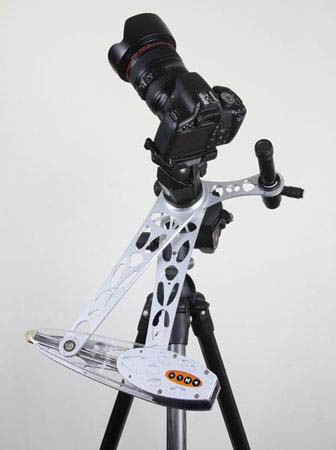
The AstroTrac TT320X-AG mount is similar to the Fornax but is discontinued. You might be able to find a used one cheap. It does have portable power as well, but you still need to add an external counterweight and base.
Vixen Optics Polarie
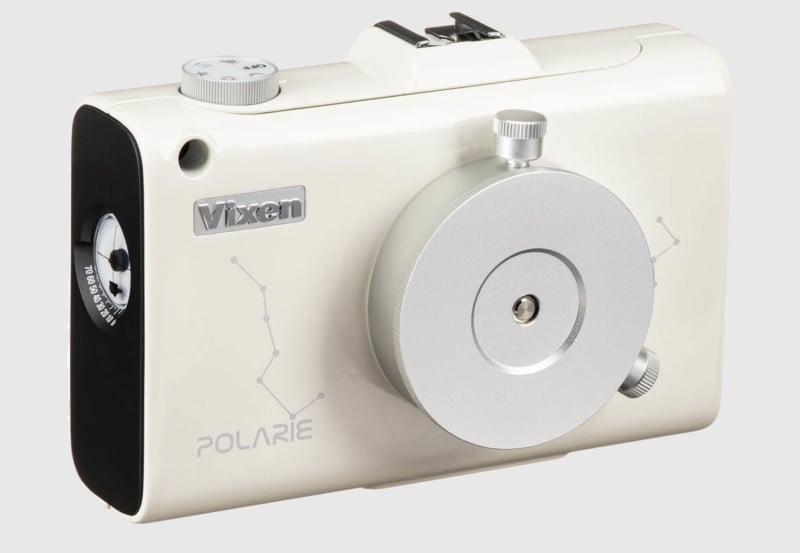
It would be strange to have a guide without the mention of the Vixen Optics Polarie star tracker. This was the first of its kind and one of the reasons portable trackers rose in popularity. But, as it is one of the first, its design is old and outdated. There is a new version of it coming soon called the “U”, but I cannot report about it until I have used it.
Conclusion
So there you have it. My recommendations for star trackers based on both my use and extensive research. There is no one size fits all option, and that is why it is important to buy the tracker that suits your needs the most! It is awesome that we live in a world these days in which these come in as many sizes and price options. 10 years ago these really did not exist in the astrophotography market, and this is yet another reason why astrophotography today is so accessible.
About the author: Daniel J. Stein is a passionate nightscape photographer working full-time in New Jersey in his family’s commercial plumbing contracting business. The opinions expressed in this article are solely those of the author. You can find more of Stein’s work on his website and Instagram.